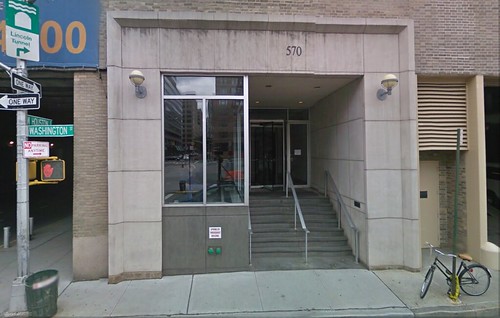
This week our start-up presented at TechCrunch Disrupt, a conference about how emerging technologies and bootstrapping start-ups are disrupting the media business. It was held at 570 Washington Street (pictured here via Google Streetmaps), a former Merrill Lynch data center in New York City’s far West Village. The place was stodgy and off the beaten path, surrounded by warehouses and Holland Tunnel seediness. But the venue was somehow fitting and played a key role in an engaging experience. It had character and soul, and it stood out. That matters a lot in a successful conference.
The whole experience got me thinking more about conference venues. While I attend fewer industry conferences these days, I still frequent them often enough, and have several hundred under my belt. I’ve also programmed and emceed many conferences, and have learned that many things come together to make a good one: smart promotion; high quality, targeted attendees; quality content and extensive preparation; relevant sponsors; selective demos; networking; attractions — and, of course, the venue.
The venue decision is a big deal. On one hand, it’s a functional and pragmatic choice, directly linked to the size of the audience you can accommodate, and presenting opportunities for, and constraints on, event activities. Having a venue booked typically determines whether you can have a conference in the first place.

While lots of attention and money is allocated to conference venues, the venue often is not appreciated nor prioritized for its ability to help set the conference’s tone and subtext. That probably explains why I’ve attended so many high-profile events in lame, homogenized and lifeless hotels and corporate convention centers.
Do people actually enjoy spending days in hotels and convention centers? No. Such places may win on availability, size and convenience, but most are dreary and have the unintended effect of degrading a conference. To make matters worse, these places usually have prices as steep as the food is bad. There are exceptions to the rule, but this is the trend.

On the flip side, many venues can actually enhance a conference. Like 570 Washington Street, noted above, following are some categories of unconventional spaces that often are overlooked, but can radically contribute to the experience and personality of a conference:
- Music and Concert Halls
- Movie Theaters
- Churches and Religious Halls
- University Lecture Halls
- Museums
- Public Parks
- Warehouses
- Ships
- High School Gymnasiums
- Botanical Gardens
- Sports Stadiums
The good thing about many (or at least some) of the venues above is that they often are very economical, and offer far more flexibility to engage decent catering and other event support. And patronizing many of these venues has another great consequence: you’re supporting public service institutions.

Finally, these unconventional venues are interesting in their own right — some rich in history, some wacky, some spiritually uplifting, and some filled with plenty of fresh air to fuel the brain for long days of discussion, networking and learning. Each has unique qualities to appropriately match to different sorts of conferences and events.
Which conference venues are your favorite? Which do you actually like?
This post also was my latest MediaPost column.
